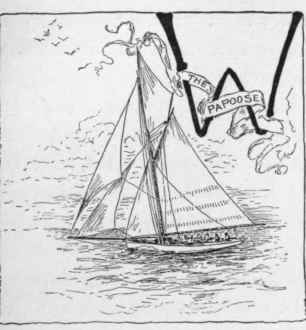Hints For Yachtsmen. III. - Starboard And Port
Description
This section is from the book "The Book Of Athletics And Out-Of-Door Sports", by Norman W. Bingham, Jr.. Also available from Amazon: The book of athletics and out-of-door sports.
Hints For Yachtsmen. III. - Starboard And Port
HEN you go a-sailing, remember that every vessel has a forward and an after part; the former is the bow, the latter the stern: these names are constantly applied aboard ship; thus, a rope is made fast forward of the mainmast, or a boat is ordered astern. Every vessel has also a right and a left side: the former is star-board, the latter port, or larboard; and in familiar speech the two sets of men, or watches, have been sometimes called Starbowlines and Larbowlines. The words right and left are not sea-terms: if a man were to say that his bunk was on the larboard side (although port is more usual) he would be set down as a mariner of experience; but if he said it was to the left, he would be considered a landsman.

No one unacquainted with nautical life can realize how incessantly these two words are used at sea; for the jibboom, there must be starboard and port guys; the ship must have a starboard and port anchor, a starboard and port light; square-rigged vessels, or those with yards, have most of their rigging alike on both sides, so we prefix to orders the word starboard or port, unless we use instead the terms weather and lee. It has been proposed to substitute the ordinary words right and left; but while with steamers or yachts no inconvenience would result, aboard sea-going vessels such a change involves far more than can be apparent to any landsman. An order to overhaul the right clewline might be ambiguous, but "Overhaul the starboard clewline" is plain. "Is the wheel a-port?" cannot be misunderstood; but how about "Is the wheel a-left?"
"Right your wheel" means to bring the rudder in line with the keel. All ancient steering-gear was identical with that used by small boats to-day, or an arm of wood fast to the rudder-head; every boy knows that to carry this tiller to the starboard side brings the rudder to the opposite side, and thus the bow of the boat is turned to port; the first improvements in steering conformed to this rule, and the wheel itself moved to the right or to the left, so that in old vessels a channel may be seen worn into the deck, where the man at the wheel has followed the tiller. Stationary wheels came, moving the rudder in the direction indicated by the wheel; but the terms were not changed. So that to this day the man moves his wheel exactly to the contrary of the order, following the old rule that the vessel must go to the side opposite that to which the helm is put.
The terms port and starboard only are in use on the sea: two vessels approaching must port the helm; if sailing-vessels, the one on the starboard tack has right of way; if steamers, one whistle indicates that each keeps to starboard; two to port; at night a green light is carried on the starboard side, a red one to port; the distinction being easily recalled if you remember that port wine is red.

BY CAPTAIN JULIUS A. PALMER, JR., Of the American Shipmasters' Association.
Continue to:


